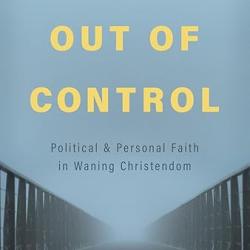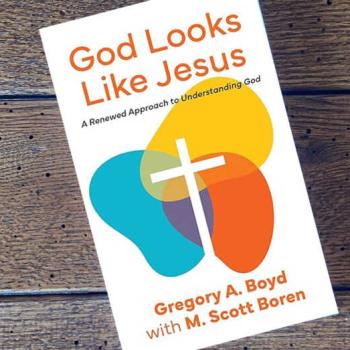“The Legacy of the Reformation in Contemporary Evangelicalism”
(Address at Symposium “The Living Reformation: 500 Years of Martin Luther” at Brigham Young University, September 15, 2017)
Roger E. Olson
Someone, somewhere, at some time, decided that the Protestant Reformation began on October 31, 1517 when German monk Martin Luther nailed “95 Theses”—propositions for public debate—to a church door in Wittenberg, Saxony. Throughout Christendom Protestant Christians celebrate the Sunday closest to October 31 as “Reformation Day” and sing Luther’s great hymn “A Mighty Fortress Is Our God” and talk about distinctively Protestant doctrines such as “justification by grace through faith alone.”
This year, 2017, is being celebrated by many Protestants around the world as the 500th anniversary of the birth of Protestantism with symposia being held in many places focusing on the Reformation. Most of them will focus primarily on two Protestant reformers—Martin Luther and John Calvin—because of their inestimable contributions to especially European and North American Protestant Christianity.
I am personally somewhat ambivalent about this celebration and focus. I will explain why in a moment. First, let me say publicly that I proudly call myself a Protestant Christian but without in any way excluding from Christianity faithful Catholics and Eastern Orthodox believers. At the same time, however, I do not feel the same enthusiasm some Protestants do for the Reformation as they remember and celebrate it.
One reason for my ambivalence is simply historical but with theological reasons wrapped up in the historical ones. Everyone who has studied the Reformation of the sixteenth century knows, but many conveniently forget, that, for the most part, especially with regard to the doctrines he espoused that brought about his excommunication from the church of Rome, Luther’s ideas were not new with him. What made Luther different from John Hus of Prague who was also a Protestant, who also founded a schism from the Catholic Church, and who a century before Luther preached the same then controversial religious doctrines? Only that Hus was burned at the stake, largely ending his ministry and movement, and Luther was not. But Luther was recognized as and labeled “The Saxon Hus” because of the similarity, if not identity, of his doctrines with those Hus preached earlier and not far away.
We could go back further to identify the real beginnings of Protestant Christianity. Peter Waldo of Italy founded a Protestant movement that survives as a distinct ecclesiastical body to this day and he preached many of the same doctrines as Hus and Luther—two hundred and three hundred years before Hus and Luther. The Waldensian Church of Italy—now existing in other countries such as Paraguay—may have historical claim to being the first continuing Protestant denomination. It is a full member of the World Communion of Reformed Churches.
Then there’s John Wycliffe of England who influenced Hus and through Hus Luther and whose followers, known as the Lollards, prepared the way for the later English Reformation. His doctrines were basically the same as Hus’s, Luther’s and Calvin’s.
So, my point is that there is something arbitrary and misleading about pinning the “birth of Protestantism” or the “beginning of the Reformation” to October 31, 1517 and identifying Luther as the first Protestant and real founder of the Reformation.
But I earlier mentioned that some of my ambivalence about the historical memory and celebration has to do with theology. Now I will explain that.
The three great Protestant reformers most talked about and celebrated were Luther, his contemporary Swiss counterpart Ulrich Zwingli, and the younger French reformer and theologian John Calvin in Geneva. These three, together with other contemporary reformers and theologians, are often referred to as the “magisterial reformers” to distinguish them from the so-called “radical reformers.” The radical reformers were a diverse group of preachers and theologians who believed Luther, Zwingli and Calvin did not go far enough in reforming the European churches. Once the break with Rome happened, the radical reformers all wanted to abolish medieval Christendom with its links between church and state. They decried and denounced the so-called magisterial reformers for permitting the princes and the city councils to determine the course and pace of the reformation. The radical reformers were restorationists; in spite of their manifest differences, they all agreed that the task of the Reformation was to recreate the New Testament church and they saw themselves as living in a cultural situation in the Holy Roman Empire much like that of the earliest Christians. And many of them were martyred, by both Catholics and magisterial Protestants, just like the primitive Christians of the Roman Empire.
As a Free Church Protestant I will celebrate the real beginning of the Reformation in 2025—the 500th anniversary of the birth of the Anabaptist movement in Switzerland. Not all of the radical reformers were Anabaptists, but that movement was the first major and enduring one, among Protestants, to declare openly that the church of Jesus Christ should not be controlled by the state or the empire. And they argued that true, authentic Christianity is a voluntary relationship with God and with the church that must involve a personal decision of faith in Jesus Christ marked by believer baptism as an act of mature commitment to Christ and his church.
Also, pushing further with my critique, while the Protestant Reformation of the sixteenth century recovered important biblical doctrines such as justification by grace through faith alone without merit, Scripture as the ultimate authority for Christian faith and practice, even over centuries of ecclesiastical tradition, and the right and ability of every true believer in Jesus Christ to approach God without an earthly human mediator, there were later Protestant movements that corrected and further reformed Protestantism in Europe and America.
Almost all, if not all, of the sixteenth century magisterial reformers were divine determinists who preached and taught that God alone, unilaterally, decides who is saved and who is damned. They denied free will participation in salvation, labeling that covert Catholicism by means of a return to human merit in salvation. In the first decades of the seventeenth century Dutch theologian Jacob Arminius and his followers, known as the Remonstrants, another word for “Protestant,” broke away from that deterministic theology of divine predestination and taught that although salvation is all of grace and by faith without good works the individual sinner must freely consent to the saving work of God in order to be saved. Like the Anabaptists before them, they were persecuted by both church and state but survived. The Remonstrant Brotherhood of the Netherlands, curiously enough, is also a charter member denomination of the World Communion of Reformed Churches—something that challenges any simplistic identification of “Reformed” with “Calvinism.”
Another later Protestant movement that added to the Reformation of the sixteenth century and corrected it was the Pietist movement launched primarily by three German Lutheran theologians: Philip Spener, August Francke, and Nicholas Zinzendorf. They added into Protestantism the idea of a “personal relationship with Jesus Christ” that is transformative even toward perfection of character. John Wesley, the founder of Methodism, was profoundly influenced by the Pietists.
I grew up in the “thick” of American evangelical Christianity; my father was an evangelical pastor and many of my close relatives were evangelical ministers, evangelists, missionaries and denominational executives. As a child I had a vague sense of Protestantism and knew a little about the Reformation from looking at books in my father’s library. One was about Protestant martyrs and contained graphic depictions of their deaths at the hands of French Catholics. We were most definitely Free Church Protestants, Arminians and Pietists, so our feelings and thoughts about Luther, Zwingli and Calvin, insofar as we talked about them at all, were at best ambivalent. But, as I recall, we did always sing “A Mighty Fortress Is Our God” on Reformation Sunday.
I attended a Pentecostal Bible college and there endured my first church history classes. I say “endured” because, now as I look back on them, I don’t think they were very accurate or did justice to the richness of church history. It may be a caricature to say that they tended to focus on which church fathers, Reformers and post-Reformation Protestants might have spoken in tongues, but there was that constant issue being taught and discussed. Our study of church history actually began with Luther, almost completely ignoring everything before him since the New Testament. Only later, in seminary and doctoral studies did I really learn about church history and theology between the apostles and Luther.
In an evangelical Baptist seminary and then in my doctoral studies in theology at a major research university I was taught and I read the history of evangelical Christianity in its many facets including the historical and theological. Not until recently was “evangelical” a political identity; in my opinion the media has created that identity. “My evangelicalism,” the evangelicalism I grew up in and studied and still consider my religious identity, was not “the Republican Party at prayer” as the American media now portray it. In fact, my more mature studies of American and British evangelicalism taught me that throughout much of the nineteenth century evangelicals were in the forefront of progressive social and political change working hard as abolitionists of slavery, liberators of women from chattel status, and even for redistribution of wealth to help abolition poverty.
Eventually I came to consider true, authentic evangelical Christianity not so much a movement as a spiritual-theological ethos. Various movements, coalitions and alliances among evangelical Christians have emerged over the centuries, but what binds them together, if anything does, is not politics or even fundamentalist theology but four or five spiritual-theological commitments identified and now generally agreed on—as the hallmarks of evangelical Christianity—by David Bebbington, a leading Scottish evangelical historian. Mark Noll, perhaps the leading American historian of evangelicalism agrees.
Evangelical Christianity is marked by biblicism which Bebbington and Noll describe as belief in and love of the Bible as God’s uniquely inspired Word written. Contrary to most fundamentalist evangelicals, however, it does not necessarily include inerrancy or literalism of interpretation. Evangelical biblicism, however, in distinction from much liberal Protestantism, does believe the Bible is different in kind and not only in degree from other religious books; it is supernaturally inspired and uniquely authoritative for Christian faith and practice.
Evangelical Christianity is also marked by conversionism which Bebbington and Noll describe as belief that true, full, authentic Christian life, life in fellowship with God, always and necessarily includes a personal decision of faith in Jesus Christ as Savior and Lord which is more than “turning over a new leaf;” it is a work of the Holy Spirit and not merely a decision to join a church or live a better life.
Evangelical Christianity is also marked, according to Bebbington and Noll, by crucicentrism which is a strong devotion to the cross of Jesus Christ as the event that reconciles God to people and people to God. Christ’s atoning death on the cross, his atoning sacrifice for sins, is crucial to evangelical faith, life, worship and piety.
Finally, according to Bebbington and Noll, evangelical Christianity is marked by activism in evangelism and social transformation. How that activism is worked out, manifested, differs much among evangelicals, but the point is that evangelical Christianity is not quietist in the sense of a mystical withdrawal from the world. At its best, when it is true to its roots and essence, it includes a robust desire and effort for changing the world.
I have personally suggested a fifth hallmark of evangelical Christianity. It is historically and theologically committed to basic Christian doctrinal orthodoxy including belief that Jesus Christ is God incarnate, the second person of the Trinity, and that salvation cannot be earned but is a gift of God’s grace.
So that is a quick and unsophisticated portrait of evangelical Christianity as a spiritual-theological ethos. Its roots are in the Protestant Reformation but it is deeply influenced by Pietism and the revivalism of the first and second Great Awakenings.
The most recent evangelical movement was the post-World War 2 one led especially by evangelist Billy Graham. It was born out of dissatisfaction with the strong influence of liberal Protestantism in American society as well as with the anti-intellectualism and cultural indifference of American fundamentalism during the first half of the century. It was founded by evangelical pastor-theologian Harold John Ockenga who, together with some other non-fundamentalist conservative Protestants with an evangelical ethos, founded the National Association of Evangelicals in 1942. During the 1950s Billy Graham became its figurehead and he remained the “glue” that held it together for almost fifty years. With his retirement from the scene that evangelical movement has dissolved; it no longer exists. However, the evangelical ethos lives on in numerous manifestations. Unfortunately for those of us who grew up in and still identify with non-fundamentalist evangelicalism, contemporary American evangelicalism is increasingly being dominated publicly by fundamentalists and religious nationalists.
So where is, where can one still find, historical evangelicalism as an ethos not identified with separatistic, narrow-minded, anti-intellectual, anti-cultural, pro-nationalistic fundamentalism? Certainly not on television or in the print media. The media have turned popular opinion toward identifying evangelical Christianity with fundamentalism and nationalistic political conservatism. As an evangelical historian and theologian I find historical evangelical Christianity still alive and well in mostly Protestant denominations such as the Evangelical Covenant Church of America—one of the least known but one of the fastest-growing denominations in the United States. And I find it everywhere I travel and read and look; it’s just that most people whose thoughts are controlled by the media don’t identify those people and places, publishers and magazines, churches and parachurch organizations, as “evangelical” because they are not fundamentalist or politically conservative in any overt or activist way.
Now I want to turn to the historical-theological relationship between the Protestant Reformation of the sixteenth century and contemporary evangelicalism—as I have described and portrayed it here.
First, the relationship between the Protestant Reformation and the evangelical ethos. The evangelical Christian ethos, as I have described it here, pre-dates the Protestant Reformation but was given great impetus by it. Unlike most medieval Catholics, Luther freely talked about being “born again” in his so-called “Tower Experience” at the University of Wittenberg as he read and studied Paul’s Epistle to the Romans. Evangelicals like to think that this was Luther’s real initiation into authentic Christian life and experience. Of course, Luther placed high value on the Bible as God’s Word and translated it into the common language of the German people so that everyone could read it. This at a time when reading the Bible was restricted largely to priests, monks and noblemen. Luther also placed great emphasis on Christ’s death as the only means of salvation understood as justification—forgiveness and reconciliation with God. His own doctrine of the atonement focused on Christ’s triumph over Satan and the “powers and principalities” under Satan’s leadership. And yet one can find other images and metaphors including sacrifice in Luther’s treatments of the atonement. There can be no question about Luther’s strong emphasis on the cross which is not in any way to deny the medieval Catholic Church’s equal emphasis on the cross. But they were different. Like modern and contemporary evangelicals Luther regarded the cross as sufficient alone to effect salvation without any need of atoning suffering or punishment on the part of the repentant sinner who has faith in the cross. Finally, Luther was an activist in seeking to bring about change in the world. True, he did believe Christ would return during his own lifetime and no doubt died disappointed that it had not happened, but his belief in the imminent return of Christ did not stop him from seeking to influence worldly society for the better. His vehement opposition to the revolting peasants continues to dismay and disappoint church historians, but Luther did put pressure on the Protestant princes to treat their peasants more humanely.
And, finally, contrary to what so many people believe, Luther was not anti-tradition; he highly valued the church fathers and especially Augustine. In many ways he and Calvin, especially, considered their reforming works in theology a recovery of true Augustinian Christianity. But more to the point here, comparing Luther with the evangelical ethos as I have described it, the Saxon reformer held firmly to ancient Christian orthodoxy and considered the major councils and creeds of Christendom authoritative. He strongly opposed the radical, anti-Trinitarian reformers such as Faustus Socinus and Servetus.
The evangelical ethos can be found before the Reformation of the sixteenth century, but Luther, Zwingli, Bucer, Cranmer, Calvin and other magisterial reformers embodied it and promoted it more strongly than medieval Catholicism even if incompletely and imperfectly. One evangelical hallmark where many of us believe they fell short is conversionism. All the magisterial reformers, including the ones I have named just now, believed in infant baptism as a means of special grace and not only as a special means of grace. Many evangelicals baptize infants. The Evangelical Covenant Church of America which I mentioned earlier baptizes infants or mature believers after conversion. The difference is that the magisterial reformers did not emphasize conversion, making a personal decision for Christ, as strongly as evangelicals do.
I think it is fair to say, and most historians of evangelicalism agree, that what I am calling the evangelical ethos really was born, or at least given strong impetus, within the Pietist movement. The founders of Pietism were faithful Lutherans but believed Luther and the other magisterial reformers neglected the importance of individual faith in conversion and the Holy Spirit inspired and empowered life of holiness. This is what my friend evangelical theologian Stanley J. Grenz called “convertive piety” and it is not to be found in the magisterial reformers as strongly as in their Pietist heirs.
Now what about the Radical Reformation of the sixteenth century—especially the Anabaptists? Without any doubt they also embodied much of the evangelical ethos and perhaps more strongly than the magisterial reformers. The one weakness in that regard was their tendency to retreat from world transformation—activism—into communal collectives separated from the world. But unlike the magisterial reformers they did emphasize the necessity of individual, personal conversion followed by baptism as a non-sacramental commitment to Christ and his church.
If I had to identify the first true evangelical Christians in the full modern sense of the word I would name the Anabaptists of the 1525 Swiss Brethren movement in Zurich. But I would criticize them for lacking a vision for world transformation and for their understandable but undesirable withdrawal into quietist communities apart from the world.
Now I want to turn to the modern and contemporary evangelical movement referred to earlier, the British and American one that had Billy Graham as its figurehead. This is what most American scholars mean when they refer to the modern/contemporary “evangelical movement.” Of course, it has much deeper roots and those I’ve already talked about. The catalyst for its formation as a coalition of relatively conservative Protestants sharing an evangelical spiritual-theological ethos was strong dissatisfaction, even bitter disillusionment, with American fundamentalism which coalesced as a movement in the early twentieth century with roots in the revivals of D. L. Moody in the late nineteenth century. Like evangelicalism, fundamentalism is both an ethos and a movement and the two can be distinguished. The ethos pre-dated the movement and will no doubt outlive it.
The fundamentalist ethos goes back at least to the rigid, narrow, dogmatic separatism of post-Reformation Protestant scholasticism that brought about many schisms among Protestants over relatively minor points of doctrine. One leading Protestant scholastic, Swiss theologian Francis Turretin, argued that, in order to protect the authority of the Bible, we must believe that God inspired the vowel points of the Masoretic text of the Hebrew Bible. In the fight against free thinking Christianity in the nineteenth century Princeton Seminary theologian Charles Hodge, a leading grandfather of the fundamentalist movement, argued for the inerrancy of the entire Bible and scorned belief in evolution as incompatible with Christian belief in the inspiration of the Bible. The fundamentalist ethos appears in any tendency to elevate secondary doctrines of Protestant Christianity to the status of essentials of the Christian faith itself.
During the first decades of the twentieth century several pastor-theologians began to organize American fundamentalists to fight against the rise of what they called “modernism” in the Protestant churches. Two early leaders, both Baptist ministers, who joined hands across the Mason-Dixon Line stand out as examples. William Bell Riley pastored First Baptist Church of Minneapolis while J. Frank Norris pastored First Baptist Church of Fort Worth. Together they formed the Christian Fundamentals Association and preached that premillennialism is a “fundamental doctrine” of Christian faith. Some Reformed and Presbyterian fundamentalists disagreed but elevated double predestination to the status of a fundamental of Christian faith. Throughout the nineteen-twenties and nineteen-thirties American fundamentalism degenerated as a movement into a cranky, fissiparous, separatistic and fragmented movement noted for being against “godless evolution,” “godless communism,” “godless racial integration” and a host of other things they perceived as “godless.”
In 1942 New England Congregationalist pastor Ockenga formed the NAE, the National Association of Evangelicals, to give collective voice to a diverse group of relatively conservative American Protestant Christians with an evangelical ethos who were not fundamentalists. Although he invited fundamentalist leader Carl McIntire to bring into the NAE his American Council of Christian Churches he knew that was not likely to happen and, indeed, much to Ockenga’s relief, it did not. McIntire and fundamentalist leaders such as Bob Jones and John R. Rice shunned the new evangelicals as “neo-evangelicals” and wolves in sheep’s clothing.
The new evangelical movement probably would not have grown and had much influence if it were not for Billy Graham, the young Youth for Christ evangelist who departed from fundamentalism and became the figurehead of the new evangelical movement. Of course, from a liberal Protestant and probably from a Catholic perspective, there isn’t much difference between fundamentalism and the new evangelicalism, but a close examination, especially an insider’s one—of either movement—reveals tremendous differences. Yet, to be honest, there has always also been some overlap and movement back and forth.
Now to the influence of the Protestant Reformation on the new evangelicalism by which I mean the post-fundamentalist evangelical movement symbolized by Billy Graham, educated to a very large extent at Fuller Theological Seminary (or by its professors through their writings), and given voice since 1956 by the magazine Christianity Today.
The leading historians of the movement were, throughout the 1960s, 1970s and 1990s, George Marsden and Mark Noll. However, many of us who grew up in the movement first studied its theological foundations by reading evangelical theologian Bernard Ramm’s extremely influential 1973 book The Evangelical Heritage (Word). Like Marsden and Noll and many other evangelical historians and theologians Ramm’s story of the “evangelical heritage” began with the Protestant Reformers, moved through the post-Reformation scholastics including the Old Princeton School theologians, and then jumped to the rise of liberal theology and then neo-orthodoxy. That story of evangelicalism strongly emphasizes the roles of Luther and Calvin and their heirs to the neglect of Pietism, Wesleyanism, revivalism and, of course, Pentecostalism.
Evangelical historian and theologian Donald W. Dayton, a Free Methodist, rebelled against this evangelical self-narrative in the 1980s and 1990s, publicly criticizing it in the pages of Christian Scholar’s Review, an evangelical scholarly journal jointly published by about fifty Christian liberal arts colleges and universities. Dayton labeled the Marsden-Noll-Ramm majority evangelical narration of evangelical history the “Puritan Paradigm” and argued for an alternative narration he labeled the “Pentecostal Paradigm.” This was at a time when the largest denomination in the NAE was the Assemblies of God and the second largest was the Church of God (Cleveland, Tennessee). Dayton argued quite cogently that evangelical history and theology was being unfairly dominated by Reformed historians and theologians and Calvinism was central to that one-sided narrative of evangelical history and theology. He also argued cogently that evangelical history, theology and spirituality have been just as much influenced by Pietism, revivalism and Pentecostalism and that the Wesleyan contribution to evangelicalism was being ignored or at least neglected by the likes of Marsden, Noll and Ramm.
I think Dayton was right, but I have preferred to label the two paradigms of evangelical self-description the “Puritan-Presbyterian Paradigm” and the “Pietist-Pentecostal Paradigm.” The former places at the center of the story of evangelical Christianity people like John Knox and Jonathan Edwards whereas the latter places at the center people like Philip Spener and John Wesley. Both paradigms admit that evangelicalism is an attempt to take the basic impulses of the Protestant Reformation along the reformers’ trajectory to its right and ultimate conclusion. But the paradigms diverge when it comes to saying which post-Reformation leaders best represent that trajectory.
I believe that one of the weaknesses of the new evangelical movement launched by Ockenga in 1942 was its being a combustible compound. Patched together with their basic differences papered over were these two very different versions of evangelical history, spirituality and theology. On the one hand were the Reformed represented, for example, by Westminster Theological Seminary and the Orthodox Presbyterian Church. On the other hand were the Wesleyan-Holiness represented, for example, by Asbury Theological Seminary and the Free Methodists. What do these two parties have in common? Well, in 1942 they shared in common an antipathy to liberal Protestantism and disillusionment with separatistic fundamentalism. They shared in common admiration for the recovery of the gospel of salvation by grace through faith alone in the Protestant Reformation. They shared in common a strong belief in the Bible as God’s inspired and authoritative, if not inerrant, written Word. They shared a common confessional belief in the deity of Christ and the Trinity. However, their differences symbolized by Edwards and Wesley, for example, could not forever be papered over.
In a way, Edwards and Wesley represent the two grandfathers of the evangelical movement. Both were born in 1703 and both became leaders of the first Great Awakening in Great Britain and North America. Both indirectly influenced the second Great Awakening in the relatively young United States—Edwards more in New England and Wesley more in the Middle States and along the frontier. Edwards was a five point Calvinist who believed that God sovereignly and unconditionally chooses whom to save and gives them the gift of irresistible grace. His admirer Charles Hodge of Princeton Theological Seminary carried on his legacy among evangelicals. Today evangelical pastor-author-theologian John Piper channels Edwards. Wesley was an Arminian who believed that Calvinism besmirched the character of God and taught grace-enabled free will and human cooperation with grace in salvation. Edwardian evangelicals tend to emphasize biblical inerrancy and view the Bible as a not-yet-systematized systematic theology. For many of them the three volume system of Hodge remains the unsurpassed summary of biblical truth. Wesley-inspired evangelicals tend not to believe in biblical inerrancy and view the Bible as the inspired story of God’s love for all people and emphasize evangelism, conversion and sanctification over theology.
And then there are the Anabaptist evangelicals who form a third paradigm of evangelicalism which time forbids exploring here. I will just say that, in my estimation, that paradigm of evangelicalism will emerge in the future as equally important and influential. Unfortunately for Anabaptists their paradigm has no single champion like Edwards or Wesley and, unlike both of them, descends from the Radical Reformation with strong emphasis on pacifism, separation of church and state, soul liberty, congregational autonomy and a strong aversion to Christendom as a unification of church and culture. However, especially among evangelical “millennials,” Anabaptism is gaining ground and emerging as a live spiritual and theological option. These younger evangelicals have little use for Luther or Calvin, Edwards or Wesley and, because “evangelicalism” as a religious identity has been so tied to those men and their legacies, these younger Anabaptist evangelicals are comfortably shedding the evangelical label and identity even if they share the evangelical ethos.
*Note to commenters: This blog is not a discussion board; please respond with a question or comment only to me. If you do not share my evangelical Christian perspective (very broadly defined), feel free to ask a question for clarification, but know that this is not a space for debating incommensurate perspectives/worldviews. In any case, know that there is no guarantee that your question or comment will be posted by the moderator or answered by the writer. If you hope for your question or comment to appear here and be answered or responded to, make sure it is civil, respectful, and “on topic.” Do not comment if you have not read the entire post and do not misrepresent what it says. Keep any comment (including questions) to minimal length; do not post essays, sermons or testimonies here. Do not post links to internet sites here. This is a space for expressions of the blogger’s (or guest writers’) opinions and constructive dialogue among evangelical Christians (very broadly defined).













